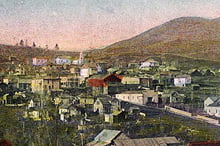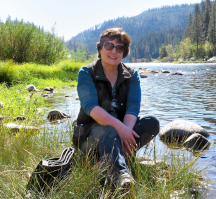No products in the cart.
Thomas and Anna

Two Pioneering Lives
By Barbara Scott
When I was a child, my brother, sisters, and I woke early every Memorial Day to gather blossoms off the lilac tree and flowers from the garden, which we took to the cemetery on the hill above Juliaetta.
We wandered the groomed cemetery, looking at the headstones carved with angels and lambs, and we thought about the children who had died so young. When I was old enough to read the dates, I wondered if a certain little Robert had been taken in the 1918 flu epidemic. We also were drawn to the graves with small flags that indicated a soldier.
Our elders took us to an old headstone at the top of the hill. “This is your great-grandmother, Anna Medora Pierce, who came out West from Kansas with her husband Thomas. She was a little bitty woman, not even five feet tall, but she could handle the prairie schooner when Thomas was out hunting and scouting.”
As I absorbed such stories over the years, I asked my parents, aunts, uncles, and cousins for details, but I didn’t pursue this interest further until 2000, when I had surgery and took three months off work. That’s when I first requested a public record, which was of Thomas Pierce’s military pension file.
In it, a Civil War comrade stated that Thomas was a “a mere stripling of a boy, about sixteen years of age, I think, when he ran away from home and enlisted.” He joined the North’s cavalry, which tugged at my heart. My eldest child was the same age.
That summer project turned into twenty-four years of research. I collected innumerable stories and clues about Thomas Henry Pierce and Anna Medora (Brewer) Pierce. Among my sources were regional newspaper articles, history books, family members, church records, and a wide range of government documents, all of which gave me a picture of what kind of people my great-grandparents were.
I now see Thomas as an outdoorsman, a restless and adventurous man who traveled many miles, a religious man, and one who kept a lot of irons in the fire. To be married to this kind of man, Anna Medora must have been one tough woman. While Thomas was off hunting buffalo, she took care of the home and their eight children, three of whom died before reaching adulthood.
In 1906, when she was fifty-eight years old, she transported her husband in the back of a wagon hundreds of miles from Juliaetta to Boise for medical treatment.
Thomas was born in Wayne County, Indiana. I found three different years reported for his birth but in several federal censuses and on his marriage certificate, his age coincided with a birth year of 1844. On the other hand, his Union Army discharge papers say he was only eighteen in 1865.
If so, he would have lied about his age when he joined the Union Army, in 1861, which wasn’t uncommon for young boys to do at the time. He was shot in the foot and ankle, was discharged, reenlisted, and fought with the cavalry in numerous Civil War battles, including the siege of Vicksburg.
This content is available for purchase. Please select from available options.
Register & Purchase Purchase Only
Register & Purchase Purchase Only

